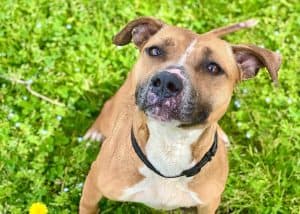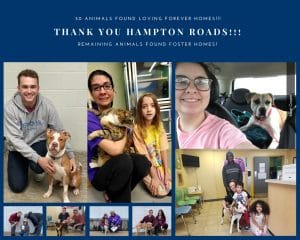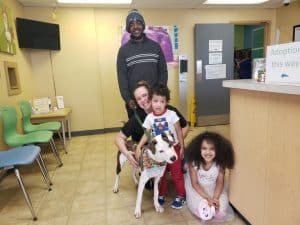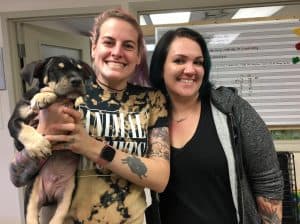The COVID-19 pandemic is unprecedented in its scale and impact on our day to day life, and for many — if not most of us — the news that our shelters and rescues would need to close or seriously limit services came nearly overnight. Moments of this significance require a swift response, and once staff and other stakeholders are notified, a clear and strategic communications plan to get the community onside. It’s worth remembering in moments like this that there’s little we do in the field of animal welfare without the community that we’re serving, and the COVID-19 crisis is rife with examples of how the community can step up to make a lifesaving difference.
To learn a bit about how one shelter, Norfolk Animal Care Center (NACC) was able to turn what could have been panic into a success, we talked to Bureau Manager for the shelter, Michelle Dosson. Michelle was just 3 weeks into her role as the leader for the shelter (bringing with her experiences as Best Friends’ national shelter outreach manager, and a decade of experience at Austin Animal Center) when she got a City-wide memo that along with many other services, would need to close. Within 3 days, she and her staff had moved all their animals in adoptive or foster homes, and luckily for all of us, is happy to share her thoughts on how we can all use communication, collaboration, and innovative thinking to get through this together.
A pandemic is not something that many of us have had a plan for in terms of response. How quickly did you have to decide on a plan of action?
Michelle: I was in a meeting with our (non-profit arm) Friends of Norfolk Animal Care Center Board of Directors on a Thursday  night when our City Manager issued a memo that all City of Norfolk offices, facilities, and business would be closed to the public starting that coming Monday. I got out of that meeting and had about dozen frantic calls, emails and texts from staff wanting to know what that meant for the shelter, and what our plan was. I reassured everybody that things would be ok, and that we would have a plan in place by the morning. Lucky for me- my friends over in the St. Louis area (Gateway Pet Guardians) had recently issued a press release plea for fosters that was wildly successful. They sent me their press release (teamwork makes the dream work!) and I worked that night to tailor it to our needs, as well as started working on our first ever (non-subsidized) adoption promotion. I knew a closure would severely limit our ability to send animals home, all the while anticipating a potential increase in intake. We had three days to get as many animals out of our shelter before we closing to the public.
night when our City Manager issued a memo that all City of Norfolk offices, facilities, and business would be closed to the public starting that coming Monday. I got out of that meeting and had about dozen frantic calls, emails and texts from staff wanting to know what that meant for the shelter, and what our plan was. I reassured everybody that things would be ok, and that we would have a plan in place by the morning. Lucky for me- my friends over in the St. Louis area (Gateway Pet Guardians) had recently issued a press release plea for fosters that was wildly successful. They sent me their press release (teamwork makes the dream work!) and I worked that night to tailor it to our needs, as well as started working on our first ever (non-subsidized) adoption promotion. I knew a closure would severely limit our ability to send animals home, all the while anticipating a potential increase in intake. We had three days to get as many animals out of our shelter before we closing to the public.
Once you knew fosters were needed, how did you get the word out and what method of communication seemed to really get people taking action?
Michelle: We issued our press release which was picked up immediately by several media outlets and within minutes our inbox was flooded with foster and adoption inquiries. Those inquiries are still (thankfully) coming in, and we are up to over 500. To date, we have received over 100 completed foster applications, and that number is increasing every day (shout out to our wonderful Foster Coordinator!) The entire NACC team was incredible — they rolled with the changes and embraced new protocol, all the while delivering excellent customer service and working tirelessly to match people with their pets.
We got great response and engagement from our Facebook Live videos and regular Facebook posts, and we made sure to update all our volunteers, partners and other stakeholders via email so they could be a part of the journey and support us.
You were able to mobilize your community to not just foster, but adopt! How many animals were you able to move in total/per day? Since that weekend, what are operations like?
 Michelle: Every animal in our shelter that was available to be fostered by the closure had a back-up foster (meaning we gave priority to adoptions, and foster-to-adopt, so all animals that were not adopted by the closure had a place to go outside of the shelter.) Staff worked tirelessly over the two days to match over 50 animals to families who were on standby for a Sunday evening pickup, should their chosen animals not get adopted. By the end of the weekend, we only had to send 5 animals into foster homes (the rest were adopted), and in the past week and a half, the number of animals in foster has grown to over 20. Some of those are foster-to-adopt, but it’s incredible that we were able to place animals as they became available (off their hold) right into foster homes.
Michelle: Every animal in our shelter that was available to be fostered by the closure had a back-up foster (meaning we gave priority to adoptions, and foster-to-adopt, so all animals that were not adopted by the closure had a place to go outside of the shelter.) Staff worked tirelessly over the two days to match over 50 animals to families who were on standby for a Sunday evening pickup, should their chosen animals not get adopted. By the end of the weekend, we only had to send 5 animals into foster homes (the rest were adopted), and in the past week and a half, the number of animals in foster has grown to over 20. Some of those are foster-to-adopt, but it’s incredible that we were able to place animals as they became available (off their hold) right into foster homes.
New developments with the pandemic happen every day, and since the closure, we have been able to implement virtual adoptions as we have settled into what I think will become our new way of operating for at least the next few months. I’m also consistently thinking about and developing contingency operational plans should our quarantine advances to a stage where our community becomes unable to pick up animals- in which case I am exploring delivery options that would involve both shelter and field services.
If you had to give 3 top quick tips for how best to communicate with the public right now during this crisis, what would they be?
Michelle:
- Be open, honest, and completely transparent.
- Know what your specific needs are and communicate exactly that.
- Remove barriers to lifesaving- make it easy and desirable for your community to want to and to be able to help you.
Much of what is happening right now is unchartered territory for all leaders in this field, and beyond – what have been some of the resources or pieces of advice you’ve gotten that are seeing you through?
Michelle: As far as resources go- the national organizations that have created resources have been literal lifesavers during this  time. The level of collaboration between these organizations that historically do not share the same lifesaving philosophy and best practices has been the silver lining we on the front lines (in shelters) have always needed. It means so much to us that the information being shared has been consistent in messaging and that the resources offered have a strategic and proactive approach versus reactive.
time. The level of collaboration between these organizations that historically do not share the same lifesaving philosophy and best practices has been the silver lining we on the front lines (in shelters) have always needed. It means so much to us that the information being shared has been consistent in messaging and that the resources offered have a strategic and proactive approach versus reactive.
As far as advice, I’ve been so fortunate to have been mentored by so many dynamic, radical leaders in our industry over the years who have always made themselves available to me whenever I need advice. The advice of not isolating yourself (and your organization), and reaching out for help when you need it, and the fact that there is an entire industry of animal welfare experts out there who are willing to share their experience, resources, and knowledge with you is what I consider the biggest lifeline.
What do you think is the next phase of response as animal welfare organizations during this crisis?
Michelle: I was just speaking to one of my former directors, Scott Giacoppo (who is the President of the National Animal Control Association) about this a few minutes ago. I think the next phase is to continue collaboration to provide consistent, information that does not instill panic in the public or animal service workers regarding animals and the COVID-19 virus.
I also think that organizations who have historically been stuck in their ways of “we’ve always done it this way” and who have formally resisted implementing new lifesaving programs for whatever reasons they believe are valid are now being thrown (or forced, for a lack of a better word) into proactive animal sheltering where new ideas, programs, and protocols are essential for organizational survival. I think this could be a turning point for many organizations who might have previous misconceptions about what was formally possible, and what their new realities are. Therefore, all the incredible streamlined resources and support that is being provided by the national organizations is so important.
What final words of advice or encouragement do you have?

Michelle: I remember years ago when I was still working for Austin Animal Services, and we were coordinating our move from our old shelter to the new one. One of our managers, Holli Odom started saying ‘We’ve got this!” whenever there seemed to be a little panic or frustration amongst staff with the seemingly overwhelming process. She made buttons for us (I keep mine on my desk) that I look to in times when I need a moment to remind myself that “We’ve got this!”. We can get through whatever presents itself, including this pandemic with collaboration, communication, and an openness to try new things that might be scary at first, but will soon become the new standard. If there ever was a time to (virtually) open our shelters up to the community and let them know what we need from them, this is it.
We have to send a ton of thanks to Michelle for writing this blog during a time when we know everyone is busy responding to the day-to-day changes of this crisis. We had the honor of working with her staff at NACC in 2019 during our Perfect Exposure Project so we’re sending her whole team a lot of love as well!
Want to snag a bit more information about crisis communications?
This Maddie’s Fund blog from 2010 is still super relevant!
Stephanie Filer, Director of Development for ARL Iowa did a great presentation for The Association of Animal Welfare Advancement just a month ago!
Or take a look outside our field at this resource guide from the Public Relations Society of America.

